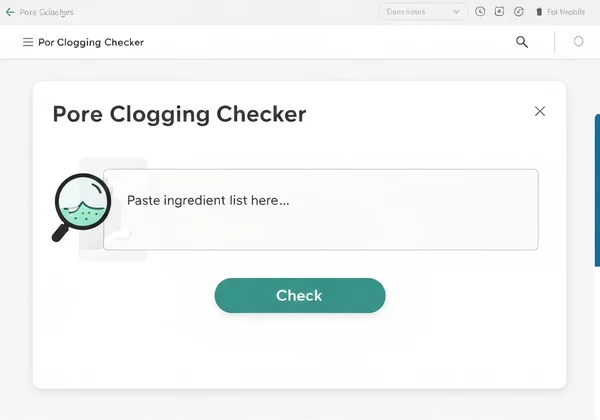Skincare Audit: Find & Remove Pore-Cloggers with Our Checker
Are you tired of mysterious breakouts, constantly wondering what's causing your acne? You meticulously cleanse, treat, and moisturize, yet new pimples keep appearing. The culprit might be hidden in your favorite products. But how to check if a product is pore clogging? This ultimate guide will empower you to become your own skincare detective, systematically audit your routine, and leverage our free pore clogging checker to finally identify and remove the hidden ingredients that are sabotaging your clear skin goals.
The journey to clear skin often feels like a confusing puzzle. You invest time and money into products that promise flawless results, only to be met with more frustration. It's time to stop guessing and start analyzing. With the right strategy and a powerful comedogenic ingredient checker, you can take control of your skincare narrative. Let’s begin your audit and unveil the truth hidden in your ingredient lists with our free ingredient checker.

Why Your Skincare Routine Needs an Audit: What is Breaking You Out?
Before we dive into the "how," it's crucial to understand the "why." A skincare audit is a systematic review of every product you use to identify what’s helping and, more importantly, what’s hurting. Many well-intentioned routines fail because they unknowingly include products with ingredients that trigger acne, inflammation, and clogged pores. If you feel like you’re doing everything right but still not seeing results, an audit is your essential next step.
The Silent Saboteurs: How Products Can Worsen Acne
It’s a frustrating paradox: the very products designed to improve your skin could be the source of your breakouts. Certain ingredients, even in products from trusted brands, have the potential to block your pores. This blockage traps oil, dead skin cells, and bacteria, creating the perfect environment for pimples, blackheads, and whiteheads to form. These problematic ingredients are the silent saboteurs in your bathroom cabinet, working against your efforts for clearer skin. This issue isn't limited to just face creams; culprits can hide in your foundation, shampoo, and even your sunscreen, which is why having an effective acne ingredient checker is so crucial.
Understanding Comedogenicity: More Than Just a Buzzword
You've likely seen the term "non-comedogenic" on product labels. But what does it really mean? Comedogenicity refers to the likelihood of an ingredient to clog pores and cause a type of acne lesion called a comedone. Ingredients are often rated on a scale from 0 to 5, where 0 is completely non-comedogenic and 5 is highly comedogenic. While this rating system is a helpful guideline, it's not foolproof. A product labeled "non-comedogenic" can still contain ingredients that irritate your specific skin type. Understanding this concept is the first step toward making truly informed choices.
Your Step-by-Step Guide to a Skincare Audit: How to Find Comedogenic Products
Ready to become a skincare detective? This three-phase process will guide you from confusion to clarity. Grab your products, open a new browser tab, and let’s get started on your path to healthier skin.
Phase 1: Taking Inventory of Your Current Routine
First, gather every single product that touches your skin. This includes skincare, makeup, hair care, and body care. Don't forget cleansers, serums, moisturizers, sunscreens, foundations, concealers, shampoos, conditioners, and body lotions. Create a simple list or spreadsheet with two columns: "Product Name" and "Ingredients." Go to each product's official website or look at the packaging to find the complete, comma-separated ingredient list and copy it into your document. This inventory gives you a complete picture of everything you're applying to your skin.
Phase 2: How to Use Our Pore Clogging Checker Tool Effectively
This is where our analysis brings clarity. Our powerful, unbiased pore clogging ingredient checker does the heavy lifting for you, saving you hours of research. Here’s how to use it:
- Navigate to the PoreCloggingChecker.org homepage.
- Copy the full ingredient list for one of your products from your inventory document.
- Paste the list directly into the input box on our website.
- Click the "Check" button to start the analysis.
Within seconds, the tool will scan the entire list against our comprehensive, science-backed database of known comedogenic ingredients. It's the most efficient way to get an objective analysis of your products. Repeat this process for every item in your inventory to build a complete profile of your routine.

Phase 3: Interpreting Your Results & Identifying Red Flags
Once you get your results, our acne ingredient checker will clearly highlight any potential pore-clogging ingredients. These "red flags" are the ingredients you need to investigate further. A single flagged ingredient doesn't automatically mean a product is bad for you, as formulation and concentration matter. However, if a product has multiple high-risk ingredients, or if a known trigger for your skin appears, it's a strong candidate for elimination. This data empowers you to connect the dots between the products you use and the breakouts you experience.
Strategically Replacing & Rebuilding Your Acne-Safe Routine
Identifying the culprits is only half the battle. The next step is to thoughtfully rebuild your routine with products that support your skin health. This isn't about throwing everything away at once but about making strategic, informed replacements over time.
The "Less is More" Approach: Simplifying for Success
After your audit, you might find that your routine is more complex than it needs to be. A great first step is to simplify. Strip your routine back to the essentials: a gentle cleanser, a suitable moisturizer, and a broad-spectrum sunscreen. By using fewer products, you reduce the variables and make it easier to pinpoint any future issues. This minimalist approach allows your skin to calm down and reset. Once your skin is stable, you can use a pore clog checker to check your products before reintroducing them one by one.
Patch Testing & Gradual Introduction: Your New Best Friends
Never introduce a new product to your entire face at once. Patch testing is a non-negotiable step to prevent widespread breakouts or irritation. Apply a small amount of the new product to a discreet area, like behind your ear or on your jawline, for a few days. If there’s no reaction, you can proceed with introducing it into your routine. Introduce only one new product at a time, waiting at least two weeks before adding another. This slow, methodical process ensures you can easily identify any product that doesn't agree with your skin.
Building a Future-Proof, Non-Comedogenic Skincare Arsenal
Your audit has given you invaluable knowledge. Use it to build a routine that is truly customized for you. Before purchasing any new product, make it a habit to use our pore clogging checker to analyze your ingredients first. This proactive approach turns you from a reactive consumer into an empowered skincare architect. You'll build an arsenal of trusted, "acne-safe" products that you know work for your skin, saving you money, time, and the emotional toll of dealing with unexpected breakouts.

Your Journey to Clearer Skin Starts Now
You now have a complete framework for taking back control of your skin's health. A skincare audit isn't a one-time fix; it's a new mindset. By questioning ingredients, understanding your skin's unique needs, and leveraging powerful resources, you can finally build a routine that delivers the clear, healthy skin you deserve.
Stop the cycle of trial and error. Your personalized path to clear skin is just a few clicks away. Take the first and most important step today. Gather your products and start your audit on our homepage!
Frequently Asked Questions About Pore-Clogging Ingredients & Skincare Audits
How do I effectively check my skincare products for pore-clogging ingredients?
The most effective and unbiased method is to use a dedicated online comedogenic ingredient checker. Simply copy the full, comma-separated ingredient list from the product packaging or website and paste it into our acne ingredient checker. The tool instantly cross-references the list with a scientific database to highlight any potentially comedogenic substances.
What does "comedogenic" truly mean for my skin?
"Comedogenic" describes an ingredient's tendency to block pores, which can lead to acne, specifically blackheads and whiteheads (comedones). However, skin reactions are highly individual. An ingredient that clogs pores for one person might be perfectly fine for another, which is why personal auditing is so important.
Can a product labeled "non-comedogenic" still cause breakouts?
Yes. The term "non-comedogenic" is not regulated by the FDA. While brands use it to indicate that the product is formulated to not clog pores, it's more of a marketing claim than a guarantee. Your unique skin sensitivity may still react to one of the ingredients, making it crucial to check the full list yourself.
How long does it take to see results after detoxing my routine?
The timeline for seeing improvements can vary widely, but many people notice a reduction in new breakouts within 2 to 8 weeks. Skin cell turnover takes time, so patience and consistency are key. Stick to your new, simplified routine to give your skin a real chance to heal and show its progress.
This article is for informational purposes only and does not constitute medical advice. Please consult a professional dermatologist for any skin concerns.